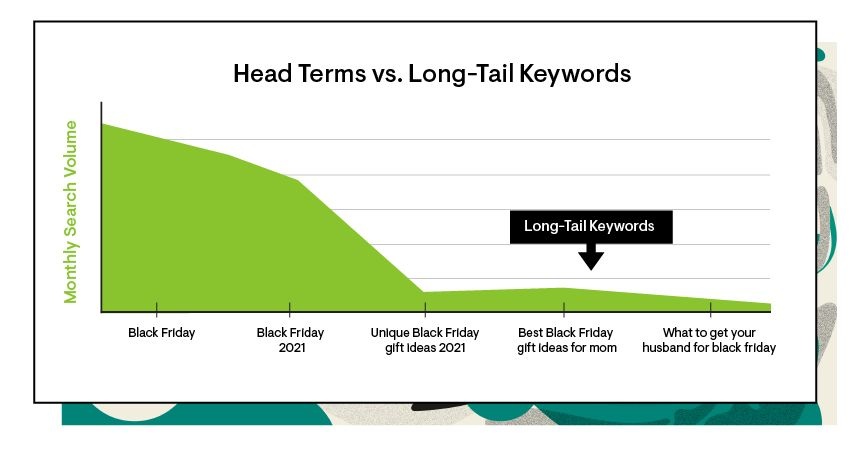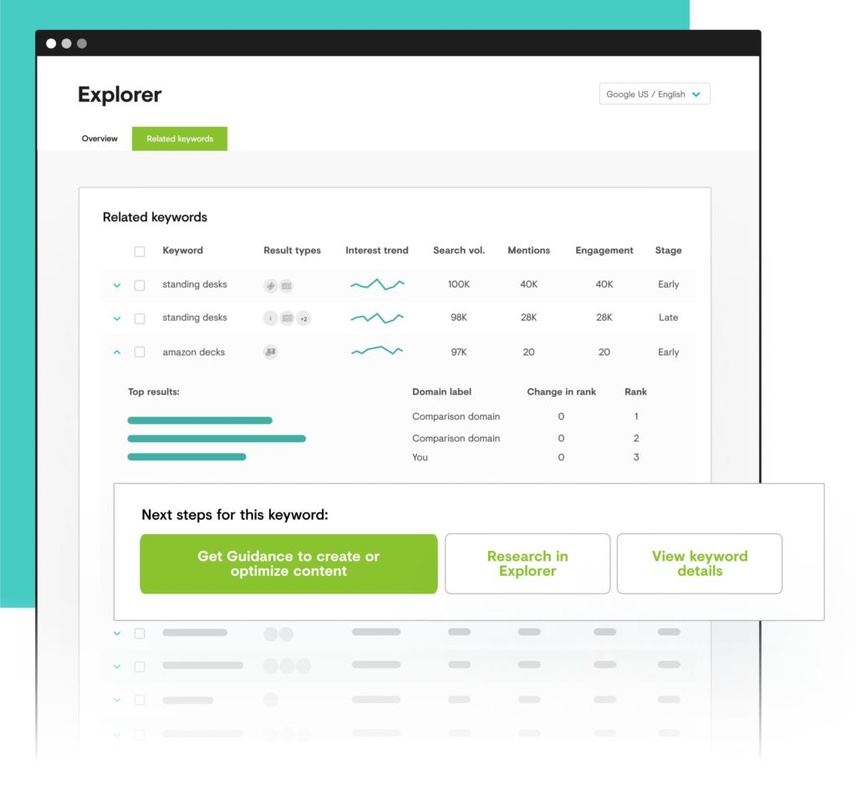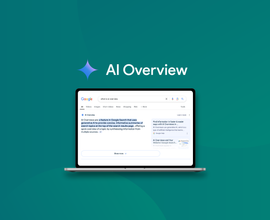What are Long-Tail Keywords? And How to Find Them
Understand what long-tail keywords are, how to uncover opportunities to rank for them, and how to optimize content for long-tail searches to drive more organic traffic.
There’s a variety of benefits to focusing on long-tail keywords while developing a long-term strategy for head terms.
In a study, Conductor found that once a long-tail searcher arrives at the website, they convert at a rate more than 2.5x higher than visitors who searched on head terms.
In this article, you’ll learn what long-tail keywords are and how to find them. With proper optimization, you just might find that you gain more traction in the search results faster than focusing on head terms, leading to more visitors and conversions.
What are long-tail keywords?
Long-tail keywords are highly-specific phrases your customers use when they search on a search engineSearch Engine
A search engine is a website through which users can search internet content.
Learn more. This type of keywordKeyword
A keyword is what users write into a search engine when they want to find something specific.
Learn more may be at the end of their buyer’s journey when they’re close to making a purchase.
Long-tail keywords are usually less competitive in the search engine result pages (SERPs) than shorter keywords (also known as “head terms”) and often have higher conversionConversion
Conversions are processes in online marketing that lead to a defined conclusion.
Learn more rates.
How long should a long tail keyword be?
A long-tail keyword is typically defined as a search query that is three or more words in length.
Using “running shoes” as a head term, examples of long-tail keywords are:
- Running shoes for women
- Running shoes for plantar fasciitis
- Best running shoe store in New York
Examples of long-tail keywords
Buyers are often looking for something specific. They’re ready to buy and just need to find a business that gets them exactly what they need.
Researching to find the right terms for your customer allows you to capitalize on keywords with low competitionCompetition
Businesses generally know who their competitors are on the open market. But are they the same companies you need to fight to get the best placement for your website? Not necessarily!
Learn more and keywords with higher conversion rates. Targeting long-tail keywords brings the potential to drive high-quality, high-converting traffic.
Let’s say you run a retail shop, and you want to create content for your blog that drives customers to your site for Black Friday gift ideas. Using Black Friday as an example, here are a few long-tail phrases that people search for leading up to this particular holiday that could potentially lead them to your content and drive them to convert with the product options you link to in your content.
- unique Black Friday gift ideas 2021
- best Black Friday gifts for mom
- Black Friday holiday gift ideas for family
- what to get your husband for black friday
Head terms, on the other hand, are typically quite short and just a couple of words long. Someone searching on these might not be looking to buy anything. There’s little chance of your eCommerce website ranking for these highly competitive keywords, let alone attracting a buyer. Examples:
- Black Friday
- Black Friday 2021

Long-tail keyword research: How do you find long-tail opportunities?
Keyword research is the process of discovering search queries people type into a search engine, and strategically including these keywords in your content with the goal of ranking higher on SERPs. Long-tail keyword research, believe it or not, is a fundamental SEO practice for converting users.
Here are a few ways to find long-tail keywords.
Research the long-tail with PIE
Create a plan for the keywords you already rank for and those you want to rank for. An easy structure to follow is the PIE method.
PIE stands for Protect, Improve, and Expand. It’s also a delectable dessert that you can reward yourself with once you’ve found success with your long-tail strategy!
- Protect: This slice is concerned with keywords that you already rank for and want to maintain where they’re at. You’re protecting their position. An example of this might be your brand name or a keyword that’s related to your product or service.
- Improve: This slice deals with opportunistic keywords where you might rank beyond the first page search results and want to improve. Sometimes it takes only a few tweaks to increase the authority of your pages.
- Expand: This slice is for keywords that perform well in your PPC campaigns but don’t have organic visibility for your business. They don’t rank and they’re likely new to your campaign.

Leverage PPC data to discover long-tail keywords that convert
Paid search marketers go after (and bid on) a wide variety of terms, tracking their effectiveness and making adjustments to focus more on terms that convert well.
Using PPC (pay-per-click) data to find long-tail keywords that convert is a secret that many seasoned SEO specialists tap into.
Look at quality scores and see if there are any landing page/keyword combinations that both convert and have a low quality score. Consider going after these terms. Being that long-tail keywords typically have low search volumeSearch Volume
Search volume refers to the number of search queries for a specific keyword in search engines such as Google.
Learn more, these often have a low competitive barrier as well.
What does that mean? It takes less effort to capture top spots.
Using Keyword Planner effectively for finding long-tail
Using Keyword Planner , one of the most popular keyword research tools, is a great way to uncover long-tail keyword ideas. Here are a few steps and best practices for finding new long-tail keywords relevant to your business.
Step 1: Think like a customer
Let’s say your business is running shoes. Describe how a typical customer thinks about your product.
Example: running shoes
Don’t anticipate long-tail search queries or questions that potential customers might search for. Keywords that are too specific can limit your ability to discover long-tail opportunities.
Example: best running shoes for long-distance runners
Step 2: Be general with a little bit of specificity
Use the right amount of detail.
Example: running shoes
Don’t be too general. A keyword that’s too general won’t give you enough guidance into what your customers are truly looking for.
Example: shoes
Step 3: Consider entering your website or a page
By keying in your website, Keyword Planner may provide more relevant keyword ideas. It’ll provide you with ideas (both head and long-tail) that it believes are relevant to your business, which is an indicator if your website is optimized the way it should be (i.e., you’re using the right keywords).
Step 4: Use more than one head term
Use multiple keywords or phrases about the same topic (your product).
Example: running shoes, shoes for runners
Don’t use terms about unrelated topics or topics only provide partial information.
Example: shoes, athletes, nutrition
Step 5: Use your location – city or state
If you have a brick-and-mortar location, include your city, state, and even neighborhood to come up with local-specific, long-tail ideas.
Example: shoes in New York
Don’t include a location if your business is solely online.
Measure traffic with Search Console
Google Search Console helps you measure your site’s search traffic and performance, putting you on the right track to making your site shine in Google’s search results for the keywords you care about.
Completely free, this is a tool you shouldn’t go without, especially as a marketer or website owner. Google shows you exactly which queries are bringing users to your site, providing data for impressions in the SERP, clicks, and average position (ranking).
Search Console does a variety of other things for crawling and indexing your site, but the golden nuggets lie within the search queries. There are typically lots of long-tail keywords – some quite relevant and others not at all – which are an opportunity to consider tracking and optimizing for.
Get long-tail and content ideas from AnswerThePublic
AnswerThePublic is a goldmine of content ideas – especially long-tail ideas. And it’s free.
The tool gathers autocomplete data from search engines (the phrases that start automatically appearing as suggested searches when you type a search query), and then spits out phrases and questions that people are asking around the keyword you’ve entered.
Going back to the fudge shop example, entering “vanilla fudge” into the tool will return question-based results like the following, which are ideal for creating fresh, useful content:
- What is vanilla fudge?
- What is vanilla fudge made out of?
- What does vanilla fudge taste like?
- What does vanilla extract do for fudge?
- Where is vanilla fudge from?
- Where to buy vanilla fudge
- Where can I buy vanilla fudge?
Two aspects of AnswerThePublic that I really like are:
- Uncover hidden treasures: You’ll find unexpected insights and hidden niches that can give organic search strategy a winning edge.
- Don’t bother with guesswork: Don’t waste time thinking about what your customers might care about. Instead, the tool allows you to fill your content calendar with real, long-tail content ideas. You can forget about writer’s block.
Says Angharad Lock, SEO Executive at Noisy Little Monkey, “AnswerThePublic enables us to get a deeper level of understanding of how people search around topics – revealing questions and queries which you wouldn’t necessarily think of off the top of your head. It’s also super easy to use and digestible.”
Use Google Trends
Google Trends is a free tool that shows you what the world is looking for, which is valuable to understand the popularity of searches that take place over a certain time frameFrame
Frames can be laid down in HTML code to create clear structures for a website’s content.
Learn more.
Aside from being able to see the popularity of a keyword over time, you can also get a comparative view of the popularity of multiple keywords at once. Google TrendsGoogle Trends
With Google Trends the interest in relevant search terms can be analyzed. This allows search queries to be valued and, over the course of time, such as for the seasonality of search terms, be classified.
Learn more also presents other interesting data points like region, related topics, and related queries, which could be useful as you gather long-tail keyword data.
Use an enterprise SEO tool
Conductor has features that can help you research and better understand long-tail keyword trends that are happening so you can optimize content for them. The Explorer feature shows you topics such as:
- Interest trends
- Social mentions
- Social engagement
- Related keywords
- How people talk about a topic

The buyer’s journey is an important part of your long-tail keyword journey
Identifying your buyer personas and the buyer’s journey to purchase can help you decide which long-tail keywords to target for content you’re planning to write. Your sales team should have an easy time deciding how to approach a potential customer if they can identify where they are in the buyer’s journey.
Since every customer has their own journey, determining their demographic, intent, and goals can yield various keyword strategies. Create a content roadmap based on head and long-tail terms to plot your personas and journey stages. This will show you which stages you need to focus most on for creating content.
Optimizing for long-tail search
Many marketers approach SEO by focusing on keywords with the largest monthly search volumes while neglecting the long tail. Focusing on these head terms is not always the smartest strategy, and the decision often comes from the executive who wants to be at the top of Google for top-searched queries.
Even though the search volumes for multiple long-tail terms can equal that of a single head term, it can be easier to move up the rankingsRankings
Rankings in SEO refers to a website’s position in the search engine results page.
Learn more for several semi-competitive terms than for one hyper-competitive term.
Did you know conversion rates for long-tail is higher than for head?
Our study shows it’s often much easier to move up the search rankings for multiple keywords whose search volumes, when combined, total that of the one desirable keyword. On top of that, conversion rates for long-tail terms were 2.5x higher than for head terms.
To see how long-tail search improves natural search visibility, get the free resource, The Benefits of Optimizing the Long Tail of Search, with no email address required.
Optimize content with long-tail keywords to maximize ROI
Optimizing your website’s assets is critical for your long-tail strategy. Big payoffs can come from minimal work.
Content should be high quality and relevant to queries people are searching. Optimize page elements like:
- Headings
- Images
- Title tags
- Meta descriptions
- Body copy
Ultimately, optimization is an ongoing experiment. You might even consider it trial and error. You’ll find that some long-tail strategies work while others have no impact, and you need to make changes accordingly. Here are some things you may want to try:
- Update content to better fit buyer personas and customer journey stage.
- Break up large pieces of content into smaller, more focused pieces. Split up head term topics into longer-tail topics.
- Combine small pieces of content into one large piece and redirect existing posts to strengthen the authority of a single page.
Low-hanging fruit: Grab long-tail keywords while working toward head terms
SEO specialists are often tasked with finding low-hanging fruit for easy wins. Low-hanging fruit is something that can be obtained or achieved with relatively little effort.
Head terms are usually high-profile, non-branded terms that executives care about most. Typically, head terms tend to be more competitive and take more time and effort to rank for – if you even manage to rank at all.
Monitoring and optimizing for long-tail searches can increase your online visibility as you continue to build out a roadmap for ranking for head terms. Metrics to track and pass along to decision-makers include:
- Organic traffic
- Organic conversions
- Keyword rankings
- Top landing pages
- Top converting pages
Try the leading organic marketing platform
I recommend you try Conductor to better understand and connect with your customers. With the world’s best organic marketing platform, you can:
- Discover customer needs
- Create winning content
- Optimize your website with long-tail
- Measure the impact of your long-tail strategy







